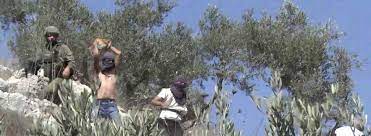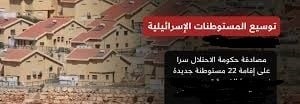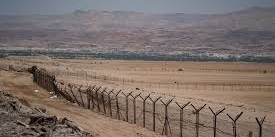By: Madeeha Al-A’raj
The national Bureau for Defending the Land and Resisting Settlements stated in its latest weekly report , that the olive harvesting season is very special in our homeland. It’s like other holidays, an occasion of joy and pleasure, such as, Nowruz holidays that color the life of society with heritage, social and cultural beauties. Palestine has been associated with this blessed tree since ancient times. Fathers and grandfathers entrusted it with care as it constituted for them a very important source of income. This is how it was in our country, Palestine until the occupation came and turned this holiday into an existential struggle and suffering with multiple faces, until the olive tree became a symbol of resistance to the occupation, the occupier, the settlers and the settlements.
Our people in our homeland accept this tree as a means of protecting their lands from the settlers, and battles with the settlers revolve around protecting its plants. Settlers in the dark of the night or even in broad daylight infiltrate to destroy them under the full protection of the occupation army, wherever you go in the governorates of the Palestinian territories occupied by the June 1967 aggression, you see expansive fields of this blessed tree covering the mountains and some plains and standing in the face of dangers between the wall and the settlements.
According to the Palestinian Central Bureau of Statistics, the area of land covered by olive tree in the West Bank and Gaza Strip is estimated at about 575,167 dunums, including about 552,534 dunums in the West Bank and about 22,633 dunums in the Gaza Strip. The number of trees increases with 11,000,000. Knowing that Jenin Governorate occupies first place in terms of the area planted with olive trees, followed by the governorates of Ramallah, Al-Bireh, Nablus, Tulkarm, Hebron, Salfeet, Qalqilya, Bethlehem Tubas, Jordan Valley, Jerusalem, and Jericho. As for the Gaza Strip, Khan Yunis Governorate occupies the first place in terms of the area planted with olive trees followed by Deir al-Balah, North Gaza, Rafah, Gaza.
The quantities of olive oil produced in these fields’ amounts to more than 35,000 tons in good years, and this number drops to less than 7,000 tons in low-production years. In general, the general annual rate of oil production over the past 30 years is estimated at about 15,000 tons.
Olive tree in our country has been subjected to repeated attacks since the first year of the occupation of the West Bank the occupation has destroyed large areas of land planted with it, according to some estimates about 800,000 trees in the West Bank’s mountains and some of its plains, it has increased due to a number of factors that are generally related to the occupation state’s control over areas C, and the restrictions imposed on the freedom of farmers to work in their fields by it, settlers and the fires they set in these fields every year, in addition to the apartheid that the occupying state established deep in the West Bank.
The effects of settlers’ attacks are clearly visible. These attacks reach their peak during the harvest season every year. In the year 2022, as an example but not limited to, the number of attacks targeting olive trees reached about 354 attacks, causing the destruction of about 10,291 olive trees. Those attacks were concentrated in Nablus Governorate, which was subjected to more than 100 attacks, followed by Bethlehem Governorate with more than 50 attacks, and Hebron Governorate with more than 45 attacks. Moreover, the apartheid wall, which isolates large areas of land planted with olive trees, especially those located near settlements, whose area is estimated at about 8% of the total area of land planted with olive trees.
The settler violence, especially during the olive harvest season represents a serious challenge for many Palestinian farmers. They destroy Palestinian olive trees, uproot them, poison them, burn them, pick them, and steal their crops in broad daylight, with the knowledge and protection of the occupation forces. The occupation authorities and forces limit the access of Palestinian farmers in various governorates to olive tree fields located near 75 settlements to several days a year, as Israeli army soldiers are deployed in the adjacent areas under the pretext of protecting the owners of the olive fields and securing their access to their lands, but in reality there are none for these citizens, no protection from settler violence.
The protection system that the occupation authorities claim to establish has been proven with conclusive evidence, and according to the testimonies of international organizations, that it is a fictitious protection system and that it is an ineffective system in preventing the destruction of olive trees by settlers. This imposed system punishes farmers by restricting their access instead of imposing the rule of law on the settlers who carry out acts of violence, as most complaints submitted to the Israeli police regarding settler attacks against Palestinian farmers and their property, but usually closed without an indictment being filed against anyone.
Furthermore, the Palestinians are denied permits to access their olive fields located behind the Apartheid Wall for ‘security reasons’ or because they do not meet the Israeli standards that require them to prove their ‘connection to the land.’ This is despite the fact that the Israeli authorities approve a larger number of permits during the olive harvest season compared to the rest of the year. Palestinians with permits must use the “agricultural gates” built along the wall, most of which are only open for a limited period during the olive harvest season. This system of restrictions prevents many farmers from carrying out vital agricultural activities throughout the year, such as plowing, fertilizing, which affects the quality and quantity of the crop.
As the occupation authorities have transferred a major part of their forces operating in the West Bank to the borders of the Gaza Strip, which these days is exposed to the most horrific and brutal forms of war ever, a war of destruction and obliteration of entire neighborhoods and residential areas. And the resulting huge human loss of life among the Palestinians in the Gaza Strip, the olive harvest season this year is the most dangerous for the lives of Palestinian farmers as it decided to close large areas in the West Bank under security pretexts and hand them over to herds of settlers and the thugs of the ‘Hilltop Youth,’ ‘Price Price’, “Rebellion, and other Jewish terrorist organizations, which take the settlements, outposts, and so-called ‘pastoral farms’ as safe havens protected by the occupation forces.
Before the ongoing aggression on the Gaza Strip and in the first half of this year, the attacks by the occupation forces, herds of settlers, and their terrorist organizations reached record levels. Those forces, along with the herds of settlers, carried out more than 4,000 attack during the first half of 2023, the governorates of Nablus, Jenin, Ramallah, Al-Bireh, Bethlehem, and Hebron had the largest share, including the fall of a number of Palestinian martyrs, the bloodiest of which occurred a few days ago during the olive harvest season in the Qusra town, southeast of the city of Nablus, where citizens went to their fields to pick their olives, and found themselves in a confrontation with terrorist organizations that tried to prevent them from doing so. Four martyrs from the village were killed, followed the next day by 2 others from the village during the funeral procession.
As for the rest of the villages and towns in the Palestinian countryside, especially in areas C, the case is not better. Many farmers are hesitant to seek to harvest the fruits of their fields after the occupation authorities closed the surroundings of more than 100 settlements in the West Bank under the pretext of security, and handed over their security to terrorist organizations. The far-right and fascist Minister of National Security, Ben Gvir, decided to distribute more weapons to the thugs, which threatens Palestinian farmers, who in such circumstances are unable to have free access to their olive fields in the vicinity of these settlements and behind the Apartheid Wall.
Moreover, settlers take advantages of the aggressive war on the Gaza Strip and continue their terrorist attacks on several towns and villages in the West Bank, resulting in the displacement of many communities, especially these located on the slopes of the eastern mountains, where the terrorist ‘Hill Youths’ thugs’ are deployed. Settlers launched terrorist attacks on Bedouin Communities during the past week, and stole their property after preventing residents from taking their belongings during the displacement to safe areas e.g. the displacement of 30 Palestinian families from Wadi Al-Siq at gunpoint and stealing residents’ cars and money.
To the east of Ramoon and Arab Al-Malihat, 6 families were displaced at gunpoint and the threat of settlers, and the Abu Al-Kabash family as well as the family of Tariq Ka’bneh from Samra were displaced from the Hamra area after attacks by settlers, too. Moreover, attempting to displace the Abu Khairy family from Al-Farsiya, but after the presence of solidarity, returned to their home.
List of Israeli Assaults over the Last Week Documented by the National Bureau:
Jerusalem:
- Imposing a curfew on the residents of a number of Bedouin communities in Khan al-Ahmar east of Jerusalem, after soldiers came to the area and informed the residents of a decision to prevent movement after 5 o’clock P.M. on a daily basis, in an effort to force them to emigrate and leave the area.
- Demolishing a house and a commercial facility in the town of Beit Hanina at a time when social networking sites affiliated to settlers incited the killing of Jerusalemites and attacking their homes. The sites published the locations of homes of Jerusalemite activists, via the Google Maps application, and among those who were incited was the martyr Khaled Al-Muhtaseb, where pictures of his home and other homes of Jerusalem martyrs were published, they also incited to target the Jerusalemite activist Rami Al-Fakhouri, the former detainee Hamza Saghir, and head of the Jerusalem Committee against Judaization, Nasser Al-Hidmi.
Hebron:
- Attacking citizens’ homes in the Sadat-Tha’la area in Musafer Yatta, wounding 2 children.
- Damaging drinking water tanks and a water network and uprooted irrigated seedlings belonging to the citizen Moh’d Abd al-Rahman al-Jubari, near Sha’b al-Batm area.
- Seizing drinking water tanks and prevented their owners from approaching them until they were completely emptied.
- Attacking citizens and their property in Masafer Yatta, south of Hebron. Some sustained bruises as a result of settlers throwing stones at them when they tried to expel them from their land planted with olive trees.
- Removing a barbed wire fence to seize land for the Abu Aisha family at gunpoint in Tel Rumeida in Hebron.
- Shooting a young Palestinian man from zero point, wounding him with critical injuries, in the village of Al-Tuwani, located in Masafer Yatta.
- A video clip published by ‘B’Tselem’ showed the settler advancing with his weapon towards a group of young men, who were trying to confront a terrorist attack by settlers on their village.
- Bulldozing two residential rooms made of brick and tin, two sheep pens, a water well, smashed solar cells, and uprooted trees and retaining walls in the “Shaab Forsa” area in Mssafer Yatta.
- Attacking homes of a number of citizens from the Al-Hathalin family and livestock herders in the village of Um Al-Khair, preventing them from leaving their homes by force of arms.
- Attacking citizens from the Al-Mahaniya family southeast of Bani Naim town, and threatened them with death.
- Assaulting 2 young men in the Jurat al-Jamal area in the village of Susya, from the Nawaja’a family, and smashed the windows of their vehicle, causing them to bruises and injuries.
Bethlehem:
- Bulldozing agricultural lands in the Ain Al-Qassis area, west of the town of Al-Khader, and uprooted dozens of olive and vine trees, others demolished 2 agricultural rooms in the same town in the “Tahr Al-Ziyah” area, and an agricultural room belonging to citizen from the Abu Mufra’ family.
- Building a settlement road in the wilderness area in Taqou, southeast of Bethlehem, with the aim of seizing it.
Ramallah:
- Chasing people while they were picking olives in the Wadi Hamad area in Kafr Ni’ma, town, others erected electricity poles and surrounded about 50 dunums of Turmus Ayya land near the Industrial Zone of the ‘Shilo Settlement.
- Building a new settlement road north of Sinjil in the lands of the Marj Arzal area.
Nablus:
- Erecting new caravans inside the evacuated ‘Homesh’ settlement on the lands of the towns of Burqa and Silat Al-Dhahr, while closing the main entrance to the village of Bazaria with barriers, attack a citizen’s vehicles, which led to a woman being hit in the head with a stone, and the windows of a number of vehicles smashed.
- Attacking the village of Jalood, leveling lands in the Karkafa in Area B located east of the village, in addition to hundreds of dunams that were controlled in the areas of Khirbet Al-Qasr and Harika Awad.
- Bulldozing agricultural lands and uprooted dozens of olive trees west of the village of Tal, in an area close to Islamic ruins, and attacked Palestinian vehicles on the Tal – Madama road.
- Firing live bullets at a group of citizens while they were picking olives in the village of Burqa, prevented the people from Qario village to pick their olives, others from the Kivat Ronim settlement, east of the village of Burin, attacked several homes in the village and fired live bullets at them.
- Storming the top of Mt. Al-Arma between the towns of Beita and Aqraba, under the protection of the Israeli occupation forces.
- Preventing scores of farmers from picking olives, and forced them to leave their lands in Khirbet Yanun, south of Nablus.
- Attacking the Daghlas family while picking olives in the plain area of Burqa lands on the road between Jenin and Nablus, stole their mobile phones and olives, before the residents confronted them and expelled them from the area.
- Closing the park road in the village of Qariot, and raised flags of the occupying state there.
Salfeet:
- Building a settlement road in the lands of the Kafr al-Dik town in the citizens’ lands in the “Derya” area, all the way to the ‘Beduel’ settlement, in preparation for seizing more lands, especially those located on the western side of the town.
- Closing the main – northern – entrance to the city of Salfeet with an iron gate, so the settlers could move freely to the “Al-Ras” outpost, northwest of the city.
- Storming the “Um Hanoun” area in the town of Kafr Al-Dik and forced the people to leave their lands and prevented them from picking olives.
- Stealing olive fruits repeatedly in the Al-Muruj area located north of Deir-Istiya. since the establishment of a settlement outpost in the place last June. Firing live bullets at the olive pickers in the village of Yasuf and forced them to leave the place
Jenin:
- Firing live bullets at farmers as they were picking olives on their lands in the village of Zabuba, adjacent to the apartheid wall.
- Closing the side roads of the Ya’bad town, and stormed villages north-east of Jenin, and turned houses into military points after closing the road linking Ya’bad, Mriha with soil.
Jordan Valley:
- Attacked citizens’ tents in Khirbet Al-Farisiya in the northern Jordan Valley, stormed the Ghazal Spring area in Al-Farisiya and raided citizens’ homes.
- Seizing agricultural land with an area of 20 dunums in the same area and plowed it.
- Deporting 2 families from the Jordan Valley by threatening them with weapons, they were the family of Tariq Hamid from Khirbet Samra and the family of Nimr Abu Alaya from Khirbet Al-Farisiya.
- Burning a citizen’s residence and destroyed water lines 800m long, feeding 3,000 dunums of cultivated land in the Waqf lands of Al-Auja.
 المكتب الوطني للدفاع عن الارض ومقاومة الاستيطان منظمة التحرير الفلسطينية
المكتب الوطني للدفاع عن الارض ومقاومة الاستيطان منظمة التحرير الفلسطينية




